by Aden Andrus • April 25, 2019
How to Fix Your Paid Search Ads
It’s easy to make mistakes on your paid search ad copy. When it comes to keywords and bids, Google gives you all sorts of information, but ad copy? You’re on your own.
As a result, paid search ad copy often feels like something of a guessing game. You’ve got a few limitations on what you can and can’t do—like how many characters you have or how you can use punctuation, symbols, etc—but most of your ad copy is really up to you.
Unfortunately, any time you’re stuck playing a guessing game, you’ll inevitably guess wrong some of the time—which is why testing your ad copy is so important. However, no one wants to waste time or money testing ad copy that has a low probability of delivering good results, so let’s take a look at several key mistakes that almost always produce poor results.
Keyword Stuffing
Twenty years ago, keyword stuffing was a big deal. In fact, a few smart people made millions off of using it to rank well organically. However, that was a long time ago. These days, people expect a lot more out of their search results—and that includes paid search ads.
Now, that being said, there’s a reason why including keywords in your ad copy is a good idea—if you do it right. To understand how all of this works (and how to use keywords properly in your ad copy), we need to talk about a psychological phenomenon called “selective attention“.
Simply put, “selective attention” is why you can ignore the conversation in the cubicle next door…until they mention your name.
The world around us is full of stimuli—so much stimuli that we’d never get anything done if we had to consciously process it all. To keep us sane, our brains filter out most of this stimuli so that we’re only consciously aware of the things that really matter to us.
As a result, when we’re searching for something online, our brains naturally filter out anything that doesn’t obviously have to do with our search. Anything that seems relevant—like keywords—is flagged for closer examination.
Google understands all of this, which is why Google bolds your keywords in your search result. They want to make it as easy as possible for your brain to identify relevant search results.
For example, here’s what you get if you search for “travel to india”:
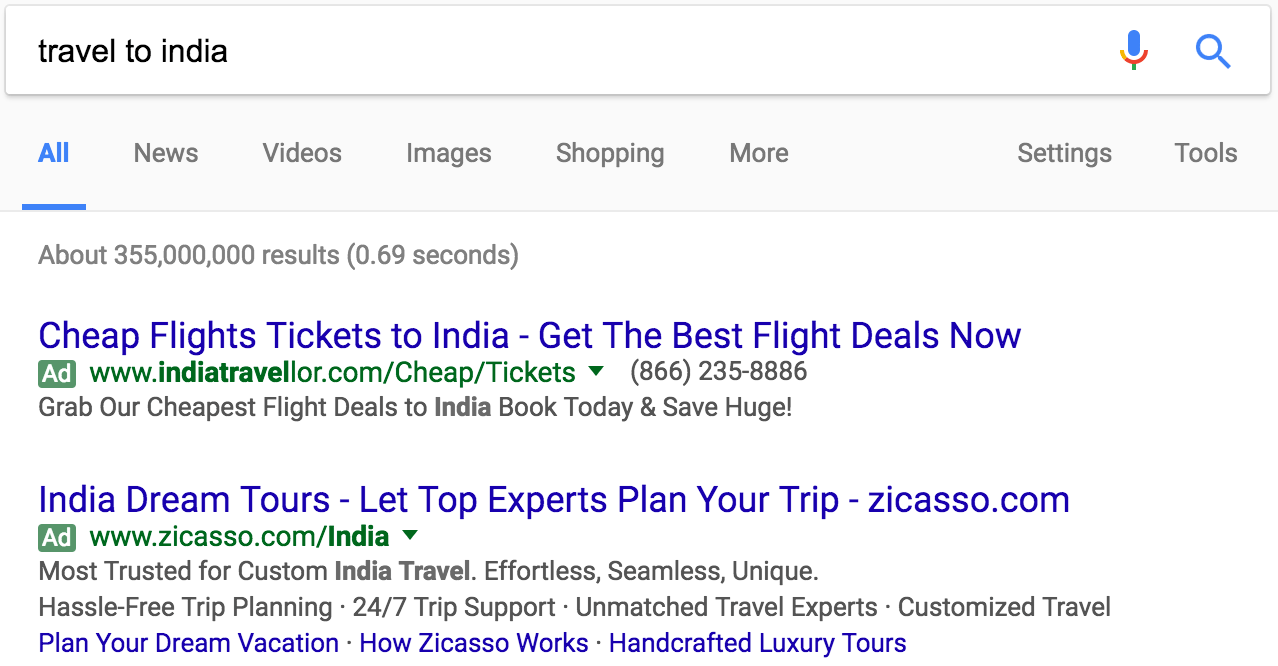
See how obvious the keywords are? Google’s doing their best to say, “Hey, this ad is relevant to your search!” Between selective attention and Google’s keyword highlighting, including your targeted keywords in your ad copy and URL is practically a necessity.
So what’s the problem with keyword stuffing? Based on selective attention, it seems like keyword stuffing is the way to go!
The problem is, we’ve all seen meaningless keywords inserted into online ad copy so many times that our brains are now trained to filter out keyword stuffed ads as irrelevant. These days, most of us automatically assume that an ad like the one below is either a scam or uselessly generic:
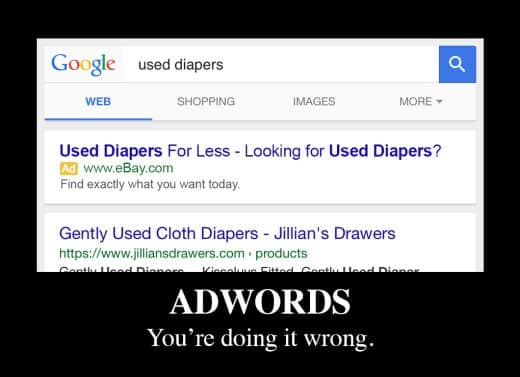
While this ad is hilariously generic, our brains have seen enough generic content to automatically filter it. Our brains are looking for relevant content that stands out in some way and generic, keyword-stuffed ad copy simply doesn’t do it.
So, while including your keywords in your ad copy is still a good way to tilt “selective attention” in your favor, you have to do it in a seamless, compelling way. You can’t just stuff in a few keywords or short phrases and call it good.
Write, don’t stuff.
You don’t have a lot of characters, but if you rely on keyword stuffing to get you clicks, you’ll be sorely disappointed. Instead, you need to think about who is seeing your ad, why they are seeing it, what needs they have and how you can speak to them. Do that, and their brains will pay a lot more attention than if you mention their keyword a couple of extra times.
Ignoring Your Ad Extensions
Unlike your titles and description, whether or not ad extensions show up with your ads is somewhat at the discretion of Google, so it can be easy to ignore them. That’s a mistake. Even though they might not show up all of the time, when they do appear, ad extensions increase the size and content of your PPC ad, allowing you to command more PPC real estate and drive more traffic to your landing page.

In fact, using ad extensions increases click-through-rate by 30-100%, so adding or optimizing your ad extensions can dramatically improve the effectiveness of your PPC campaigns.
From an ad copy point of view, ad extensions are something of a must because they give you more room and opportunity to write about what you’re selling. There are a wide range of different ad extensions to choose from, but for the sake of our discussion, I’m going to focus on the most important extensions for ad copy: sitelinks, callout extensions and structured snippets.
Sitelinks
Sitelink extensions are fairly self-explanatory: they’re links to specific parts of your website—plus some copy.
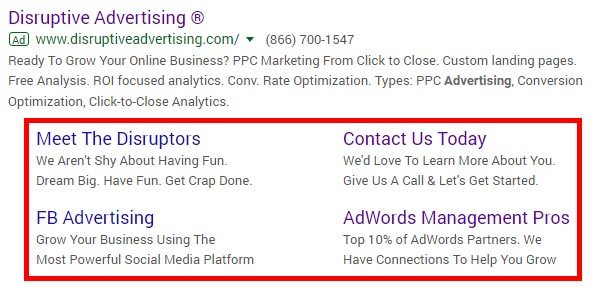
Since sitelinks show up in addition to your regular copy, make sure that your sitelink copy contributes something new to the content of your ad. Getting to say something extra in a text ad is great, but only if you’re saying something that adds value.
Callout Extensions
Remember how in the first section I said: “write, don’t stuff”? Well, callout extensions give you a place to stuff all of those oh-so-important keywords.

With your actual ad copy, keyword stuffing feels false and artificial. However, the compressed design of callout extensions makes keyword stuffing feel fairly natural. You can’t fit full sentences, so people are looking for their keywords in callout extensions—so why not give them what they’re looking for? Callout extensions are the perfect place to list benefits, pain points, product models, features, etc.
Structured Snippets
Finally, structured snippets toe the line between sitelink and callout extensions. Like sitelink extensions, they have a header and content, but like callout extensions, their design is a good fit for short content, like keywords.
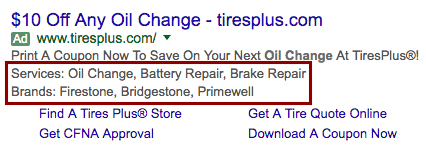
However, the current design of structured snippets actually makes them kind of hard to use to full effect, so you’ll definitely want to test including them with your ads. Yes, they’ll give you more real estate in the SERPs, but their readability can be kind of low, which can actually hurt the performance of the ad.
Solving for the Wrong Need
Finally, one of the most common, most damaging paid search ad copy mistakes that we see is focusing on the wrong need. In general, most advertisers tend to see their customers through their business’s lens. If there’s a feature or selling point to their product or service that is a big deal internally, they naturally assume that it must be a big deal to their customers, too.
That isn’t always the case.
The problem is, your customers don’t care about your business. They care about themselves, their needs and their own challenges. Those often don’t match up with what your company values. And, if your advertising is focused on things that your customers don’t care about, they won’t care about what you’re advertising.
Instead, your ads should address your customers’ issues—the ones that led them to search online for a solution. For example, look at the ads that show up if you search for “renew passport”:
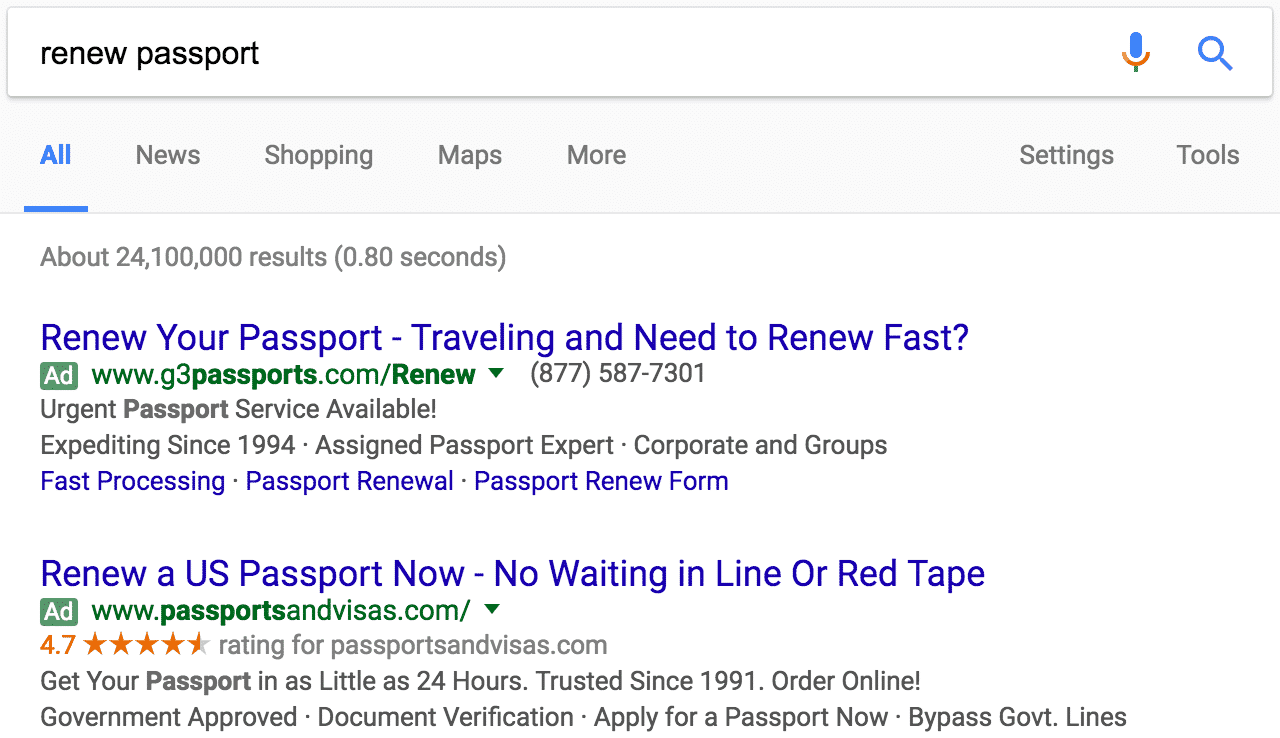
For most people, if they’re searching for “renew passport”, they probably are in one of two situations: they’re traveling internationally soon or they’re looking for a way to avoid the line at the passport office.
As you can see from the ad copy above, both of these companies have written copy that clearly addresses both of these scenarios. And, they do it a way that feels natural and customer-focused. It’s all about the customers’ needs, not the companies’ values. There’s no keyword stuffing to be found and the ads include several ad extensions. It’s an all-around win!
When you focus your paid search ad copy on the right needs—the needs of your customers—it’s often fairly easy to come up with compelling, attention-grabbing content. So, if you’re struggling to figure out how to write good ad copy, the best place to start is by thinking about your business from your customer’s perspective. Once you know what they need or want and how your business solves their problems, you should be well on your way to fixing your ad copy!
Conclusion
Ironically enough, while Google supplies advertisers with all kinds of great data, when it comes to the most important part of your campaigns—the ads people actually see—you’re kind of on your own. This is why it’s so important to really think hard about what you write and who you’re writing for.
Then, once you’ve come up with some good ad copy, test everything! The only real, data-driven way to figure out what ad copy produces the best results. After all, even if you avoid the paid search ad copy mistakes we’ve covered here, no one bats a thousand. You still need to test to identify what works best.
In the end, great ad copy takes time, practice and more than a little effort, but trust me, the results are worth it.
By the way, if you’d like some help putting together quality ad copy for your campaigns, let me know here or in the comments. I’d love to help!
How do you make the most of your paid search ad copy? Any additional advice you’d add to this article? Leave your thoughts and questions in the comments below.





